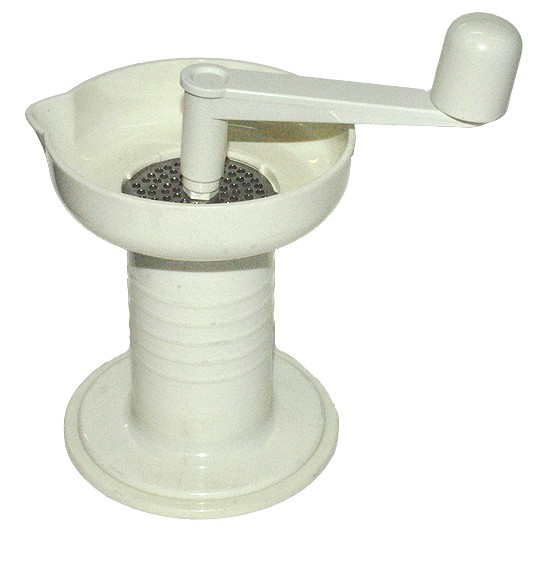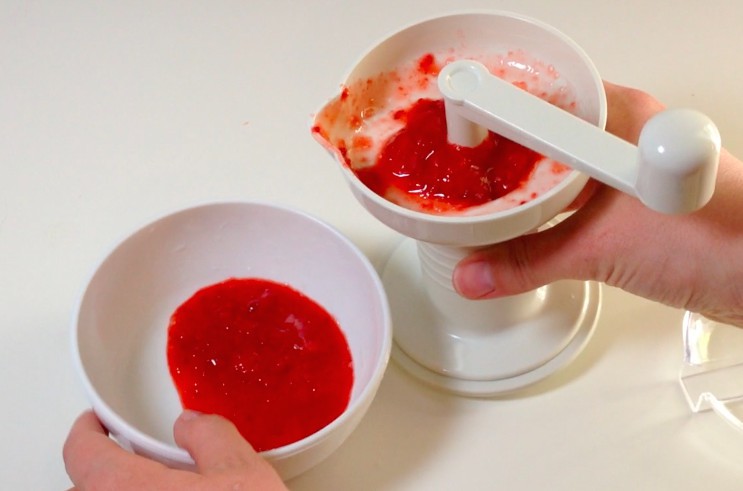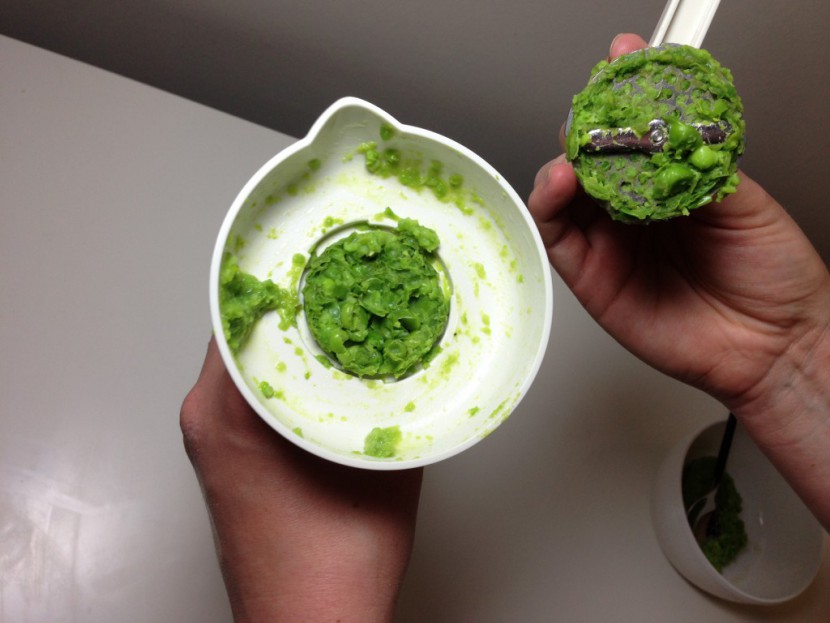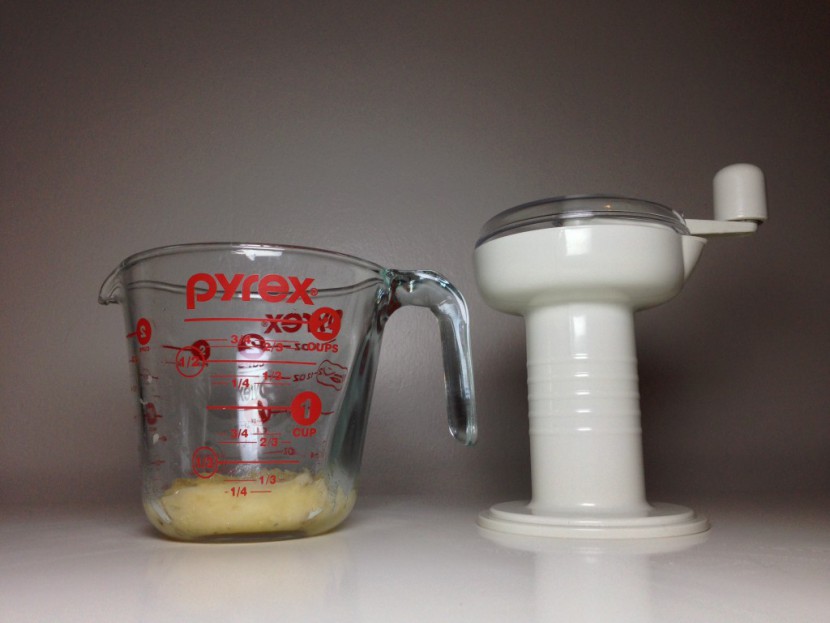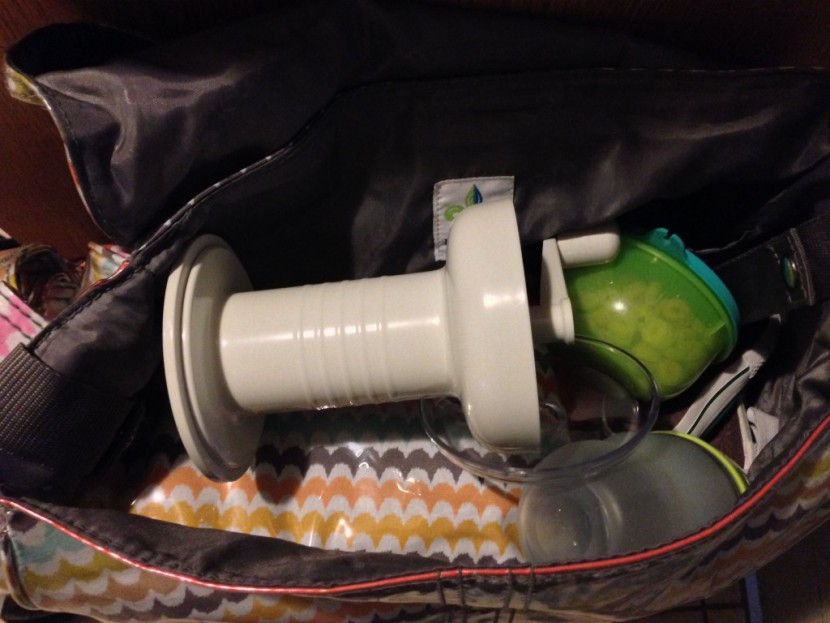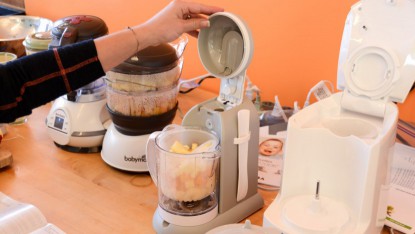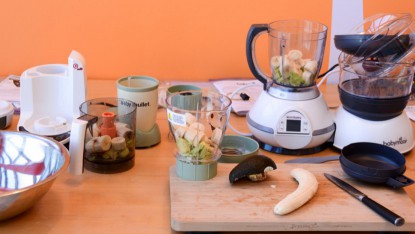Kidalog Food Mill Grinder Review
Our Verdict
Our Analysis and Test Results
Puree Quality
We spent a significant amount of time testing the Kidalog and were astounded at its consistent results. Not matter what put in it- bananas, kiwi, mangos, rice, quinoa, chicken, peas, blueberries, avocado, grapes, beans, roasted carrots, and sweet potato- this little machine rendered the food a a near-perfect, finely pureed consistency.
That being said, unlike our other award winners, the Sage Spoonfuls Puree and Blend and the Baby Brezza Elite, we did note a few foods that had some issues being milled. Because of the size of the holes on the metal disk, skins on blueberries and grapes had a tendency to gum it up. A little extra pressure exerted on the stem helps alleviate the problem, but don't be surprised by the leftover skin caught in the disk. We also noted that while you can grind harder things (such as dry rice or oatmeal), this could potentially shorten the life span of the product. We tried to stick with softer foods that had already been cooked well and were pleased with the results. Because of the minor issues we had with harder foods, we gave it a score of 7/10.
Ease of Use
The Kidalog Baby Food Mill has four parts: the base and top (which are made of plastic), the metal disk and blade that are attached to a crank, and a see-through plastic lid. To use, you put to base and top together, insert whatever food you choose to mill, then secure the metal disk by locking it into the plastic holding and place the lid on top. It is essential for the metal disk to be locked into place in order for it to function, so make certain of this (we had a little bit of trouble with this initially). Once the parts are correctly in place, simply grip the top with one hand and gently press down toward the base while the other hand turns the crank. Once the top has reached the bottom of the base you will have approximately 1/2 cup of pureed food, ready for baby to eat.
One thing we noticed is if the food you are attempting to mill is harder in consistency (some kinds of meats, carrots, apples, etc.) then you should not exert a lot of pressure on the top component. You want the metal disk to do the work to grind it down. While you can get away with exerting a lot of pressure with softer foods, it is not recommended. Be warned, juicy foods tend to “pop”, so always utilize the plastic cover! We noticed the cover does have a tendency to pop off if you do not hold the mill steady so go easy on it to avoid spills.
Much like its counterpart, the Boon Mush Manual, you should not expect to be able to reuse the mill without getting your hands dirty. The design makes it virtually impossible to do so without making a bit of a mess. This renders it less than ideal for use at restaurants or other places where one might not have access to a sink to clean it in preparation for the next type of food.
Another downside to using this product is how challenging it is to get sticky food (such as rice or bananas) out of the mill once it has been pureed in order to feed baby. The handle is cumbersome to maneuver around and inevitably we found ourselves scraping the grinding disk with a spoon to get all of the leftovers. Overall though, this was not a tremendously problematic issue.
Ease of Cleaning
Cleaning the Kidalog is fairly simple. All of the parts come undone without a lot of effort, and by utilizing a baby bottle cleaning brush, one can easily clean the interior parts. Scrubbing the metal disk is a breeze, however, watch for parts of food that did not mill through (such as grape skins or apple peels, as mentioned above) as these tend to clog the device. When finished making any food, it is a good idea to rinse off all of the parts to avoid remnants drying into place, especially if you do not have time to properly clean it immediately after it has been used. This product is dishwasher safe on the top rack, which makes for simple sterilization- just be certain to scrub out any food remnants before! We gave the Kidalog a 8/10 in this category, the same as the Baby Brezza Elite. Only the Sage Spoonful scored higher.
Capacity
This product produces a small quantity of food for each use- approximately 1/2 cup (depending on what you are milling) per session. While you could get away will milling a large quantity of food in one sitting, it would be a pain, as you would have to sterilize it between each use because your hands have to touch the grinding disk in order to insert more food. Of course, you could always insert food from the bottom, but if the food is watery it will leak out of the device. It really is not meant to be used to mass-produce baby food, so we recommend it for fast on-the-go meals, or for sharing your dinner with baby. The Kidalog scored a 7/10 in this area because the capacity of food it produced was different with each kind of food we used. We found softer foods like bananas and avocados yielded far more food than apples and mangos. All of this really comes down to the fact that the Kidalog is man-powered and only so much force can be applied to the machine.
Durability
Out of the bag (yes, it arrives in a bag) the Kidalog Baby Food Mill does not look like a formidable baby food maker, but it holds its own against its competitors. Its plastic base and metal grinding disk are surprisingly sturdy. We exerted a lot of pressure to grind some of the foods in our test kitchen and this rudimentary device held up extremely well. The base and top seal perfectly, which prevents leaking from juicier foods such as kiwis. We really appreciated this about the device and awarded it a score of 8/10, just one point lower than each of the other award winners.
Portability
The Kidalog Food Mill was designed with portability in mind, which is why we awarded it the highest score we gave out in this category- 9/10. It has a minuscule footprint in the kitchen cabinet and can easily fit in a diaper bag. Not requiring a power outlet to function is a tremendous advantage, allowing for ultimate portability. We would have awarded it a perfect score, if not for one major downside- it has no way to contain its own mess. Should you decide to take it on the road with you, be prepared to store it in a bag that will prevent it from leaking mashed food. We did discover that it does fit in a gallon size ziplock bag, but this seems like an easy problem to prevent by simply creating a plastic lid for it (much like the Boon Mush Manual). This would allow for self-containment and prevent the messiness.
Value
If you want an inexpensive product to help you easily mash food for your baby, but you are not necessarily committed to buying an all-in-one steamer or have the space for a blender, then the Kidalog Baby Food Mill might be the right choice for you and your baby. With a price point under $20.00, you just can't beat the value it offers.
Conclusion
Its simple design, excellent price point and slight stature make the Kidalog Baby Food Mill an ideal product for parents making their foray into introducing food to baby. We often found ourselves turning to the Kidalog in a pinch when our little man became “hangry” and needed food right away. We found milling foods with it to be a breeze- just drop prepared food into the mill and with a little elbow grease, you have and a tasty meal ready for your little one in moments.


